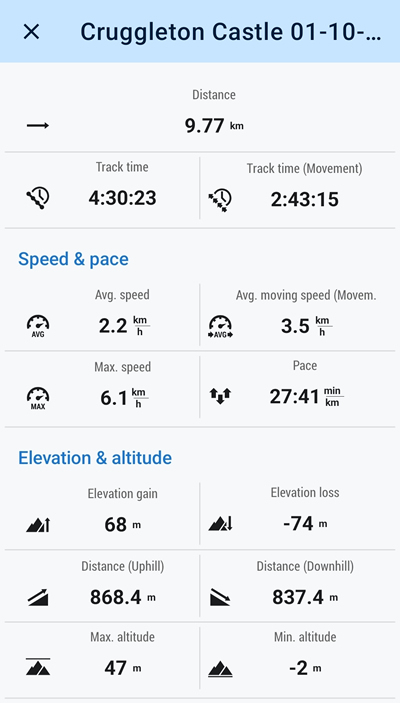Cruggleton Castle
Wednesday 1st October 2025
10kms
4hrs 30mins

As stated in my report for Merrick which we climbed yesterday, our plans for hill walks were quickly changed due to the heavy rain and wind forecast for today and tomorrow, and so, thankful that our gear was well dry by this morning we were enroute to the coastal village of Garlieston in Wigtown Bay for a coastal walk to the ruins of Cruggleton Castle, a historical site thought to have been in use since as early as the 1st century AD through to the 17th century AD, or for the modernist, 1st century CE through to the 17th century CE.
Leaving Garlieston on a slightly muddy woodland path it was an easy stroll just above the shoreline through the trees to Rigg Bay where, in 1943 in preparation for D-Day on 6th June 1944, testing was carried out on the Mulberry floating harbours used immediately after D-Day to bring vital re-enforcements of men and supplies such as petrol, oil and much needed heavy fighting vehicles ashore in Normandy until such time as the Allies captured a land harbour from which to unload supplies. In effect they remained operational for 10 months, supplementing supplies coming from the port of Cherbourg, which was recaptured by American forces on 27th June 1944 but it was not until mid-August that the port was brought back into limited use, thus it could be argued that without the Mulberry harbours, D-Day and the final breakout from Normandy may not have been the success it was.
Beyond Rigg Bay, the path rises slightly as it meanders through a nicely wooded area and climbs above the shoreline onto the headland on which stands the ruins of Cruggleton Castle, a slightly older historical ruin than those of the concrete structures from the Mulberry testing in Rigg Bay. In the trees we had been sheltered from the wind and rain, and even had a fleeting thought that maybe the weather was not as bad as forecast and we could have been on the hills today. Not so as we stood on the open headland in the ruins of the castle, it was a bit “baltic” and blowing a “hoolie”.
This is an out and back walk, and so we made our return as far as Rigg Bay at which point we wandered off through the grounds of Galloway House, the ancestral home of the Earl of Galloway, built in 1740 by Lord Alexander Garlies, son of the 5th Earl of Galloway. Continuing with a historical theme, the stone estate walls were build by Napoleonic prisoners of war. The house has been in private hands since the early 1900s. Returning to Garlieston we found a real gem of a café, The Hive, where the cakes and scones where just to die for, an excellent way to end a very interesting coastal walk.
Thanks everyone for your company.
Photo Gallery
Click the buttons to select photo size.





















